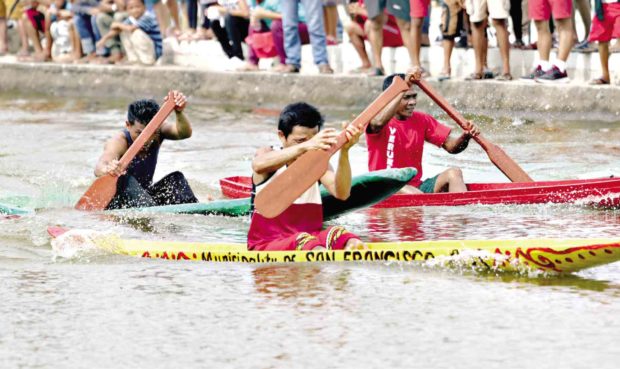
Manobo show off their natural skills in rowing boats during the Bauto Race. —ERWIN MASCARIÑAS
PROSPERIDAD, Agusan del Sur — Manobo rowers crossed the finish line during the Bauto Race here with ease.
It was not surprising as the indigenous people were known for their rowing skills that had become part of their lives.
They traveled and traded on “bauto” (Manobo for boat) and rowed for kilometers upstream and downstream on the mighty Agusan River, a 390-kilometer water route that stretched from Compostela Valley to Butuan Bay.
Rowing, for the Manobo, who used to dominate the Agusan provinces, was necessity.
The Bauto Race distance was just 500 meters.
Strong currents
Officials made Bauto Race part of Naliyagan Festival, which started on June 12 in this province, to pay homage to the Manobo’s legendary conquest of Agusan River, which they navigated using only wooden boats.
Manobo chieftain Jose Bunilla, former provincial board member, said Manobo of old battled with Agusan River’s strong currents on a regular basis.
Bunilla said bauto became an integral part of Manobo life, turning the tribal folk into expert boatmen and helping them survive.
He recalled that the late Democrito Plaza, one of Agusan’s most known politicians, used bauto in the early 1960s to trade tobacco and other goods, “which made him later a billionaire.”
Naliyagan Festival (“naliyagan” is Manobo for chosen one) was a tribute to the Manobo people. It featured their culture and art.
Foreigners, like Canadian video blogger Kyle Douglas Jennerman, known to netizens as Kulas, said they were awed by the Manobo skills in navigating the often treacherous Agusan River.
How they lived
Sammy Bacolod, event organizer, said Bauto Race was distinct from other boat races because it depicted “authentic indigenous peoples’ way of life in Agusan Marsh.”
Although roads and bridges now dot the landscape of Agusan, most indigenous peoples still relied on bauto for transportation.
Most, especially those from areas along the river, still load their boats with goods (corn, fish and others) to trade in market centers.
At least 60,000 Manobo people reside in the two Agusan provinces based on the 2005 census. —Chris Panganiban